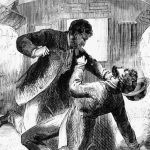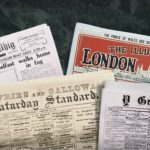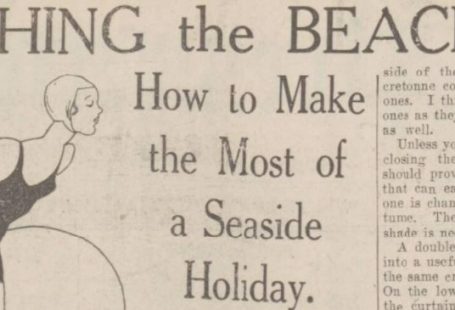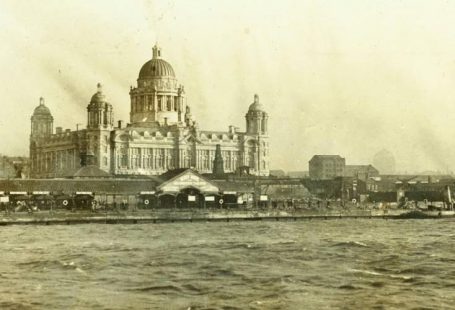As part of our railway history month on The Archive, we’re delighted to welcome a very special guest blog post from Dr Mike Esbester, Senior Lecturer in History at the University of Portsmouth and co-lead of the ‘Railway Work, Life & Death Project.’ In this special blog, Mike takes a look at the dark side of railway work, and how the British Newspaper Archive has helped to inform research into railway accidents from days past.
The Dark Side of Railway Work
The smell of the steam and ash. The whistle sounding as the express roars past in a blur. The driver in charge of the train & ‘all the fun of the footplate’ – perhaps in your mind’s eye you’re the driver?

We might have a rather idealised view of the steam-era railway – now well over 50 years out-of-date, as steam-hauled services on the ‘regular’ railway network ended in 1968. And as always with the rose-tinted specs view of the past, it hides a lot – include the gritty bits of railway life.

That grit includes the hard work necessary to keep the railways running – and the dangers railway staff encountered on the job. Whilst the spectacular passenger crashes were frontpage news for the national papers, staff accidents though rarely seen were far more numerous. By 1900, for every passenger casualty there were nine workers hurt. These accidents to employees happened largely in ones and twos, and weren’t spectacular. As a result, they didn’t tend to make the national press; so where do we find out more about staff accidents?
The Railway Work, Life & Death project
That’s where the ‘Railway Work, Life & Death’ project comes in. For some accidents – so far 21,000 between 1900 and 1939, but with more to come – the rail industry investigated what happened. That was a small fraction of the total number of accidents, which in 1913 alone amounted to nearly 30,000 cases. Even though they’re incomplete, the surviving records give us a great insight into what was going on, who was involved, railway operating practices and in some cases what happened after the accident.

These records were only available in hardcopy at the relevant archives – including The National Archives of the UK and the National Railway Museum. They were also unindexed. Our project was devised to bring together volunteers – without whom it wouldn’t be possible, so our thanks to them – to transcribe and summarise the accident reports, which we’re then making available to you, free, via our project website.
Since 2016 we’ve been working with small teams at each of the project partners – the University of Portsmouth, the National Railway Museum and the Modern Records Centre at the University of Warwick – to make the records available – and now they are! This is a huge resource for all researchers, now amounting to around 24,000 records.
This is made even more powerful when we combine it with different datasets and sources, including press accounts of railway staff accidents. Whilst the accidents might not make the national press, very often they did make the local press – an invaluable source for this research.
In/visible disability
Given so many railway workers were hurt at work – including many with life-changing injuries – disability amongst the railway workforce would have been more obvious to nineteenth or early twentieth century observers than we might expect. This speaks volumes about the cultural invisibility of disability – now, as much as then.
The RWLD database shows us some of the disabled workers. This is both via the disabilities caused by accidents to railway staff and pre-existing disabilities which railway workers had before they started work.
One man who appears is Robert Stanbury. He was involved in inadvertently causing an accident in 1911, at Pontdolgoch station, in Wales. Detailed more in this project blog post, he was improvising a work-around for the fact he was missing an arm. However, we didn’t know how he lost his arm. The answer came through a piece of collaborative research from a contributor to the project, Derek Savage – and the British Newspaper Archive provided plenty of evidence for his blog post. It turned out Stanbury had an accident at work on the railway in 1868, and was subsequently found employment in other roles it was then possible for him to undertake.

The value of using the digitised press to support the RWLD work is clear. It takes us beyond the immediate circumstances of the accident report found in the project database and puts that person in as wide a context as possible. Sometimes the flow of information might usefully be reversed, too. Reading the report, below, on the death of John Duncan in 1930 we might conclude that it was a sad accident.

However, what the newspapers don’t say is that Duncan had already lost the sight in his left eye. Instead, this information is found in the accident report featured in the RWLD database. The database also notes that Duncan wasn’t provided with someone to keep watch for moving trains – a common situation at the time, and tragically something we see time and time again in the 40 years so far covered by the database.
The drama
The vast majority of staff accidents were fairly mundane – a pinched thumb here, a slip, trip or fall there; sadly people being hit by moving trains was all too common.
Occasionally, however, an unusual case appears in the RWLD database. When we were confronted by the report of the incident involving William Williams and William George, we knew we had to look into it.
From the database we could see that at Milford Haven, Wales, on 19 February 1923 a bridge had been opened to allow the passage of a ship. However, a steam engine was driven along the line and plunged into the harbour. Two men escaped, but Williams and George drowned. As we’d anticipated, with a case like this, it did receive newspaper coverage – though perhaps not as much as we’d expected – and that gives us additional detail and eyewitness accounts of the accident.

Not everyone included in the RWLD database was a railway worker. Plenty of people had reason to be on or around railway property, like coal and timber merchants, farmers, and Post Office staff. For one unfortunate woman, though, her only act was to be walking past the engine sheds in Brighton at the wrong time on 30 September 1922.
At just before 1pm, Margaret Quelch was passing the shed, when she was showered with bricks. One of the engine drivers had left a locomotive with enough steam that it started to move – back into the brick wall near which Quelch was walking. It might have been relatively slow speed, but dramatic nonetheless – and found in the British Newspaper Archive.

A man’s world?
Margaret Quelch wasn’t a railway employee – and though for the period our project covers men were by far and away the largest part of the workforce, plenty of women worked on the railways. They tended to be in roles deemed ‘appropriate,’ like cleaning, laundry and as seamstresses. As a result, relatively few women appear in the RWLD database – but some do.
This includes Ada Davies, gate keeper at Abergwili in Carmarthenshire, Wales. On 20 March 1922, Davies, 59, was closing level crossing gates to road traffic when she was hit by a train which had passed a signal set at danger. She had been in this role for 16 years by the time of her death. We get a different emphasis from the press reports of the fatality. There’s more of the ‘human interest’ aspect – the blind son, for example, but also the continued presence of details and expressions which were very much of their time.

Picturing the workers
Whilst most accidents to railway staff at work involved one or maybe two individuals, sadly sometimes more were hurt. These cases tended to involve track workers, maintaining the railway lines in amongst moving traffic (something still done to this day, though efforts are being made to phase this out). In one case in the RWLD database, four men were hit by a train and killed near the village of Wilmcote, Warwickshire, in March 1922 (the centenary of which the project helped to mark).

Courtesy: Railway Work, Life & Death project.
Even more tragically, this wasn’t an isolated case. Many other cases like it appear in the RWLD database, and in the pages of the newspapers. That includes the accident around six months earlier, at Stapleton Road in Bristol, in September 1921, which killed six men and injured another. Given the scale of the accident, it attracted significant coverage – and provided us with images of some of the men involved. This was incredibly powerful when we researched the case and marked the centenary.

Whilst we’d rather find images of the railway workers for other reasons, that the newspapers sometimes included them after a fatality means we have a potential route into seeing the men and women concerned. However, we also need to exercise caution. In talking with descendants of one of the men who died, we learned that in the haste to get the images of the men involved in the accident, the Western Daily Press inadvertently used the wrong image for one of the men. Stephen Francis was not pictured – instead, it was his brother, Charles.
Where next?
We want to see you making use of the RWLD database in your research, especially where you can combine it with other sources such as newspapers. There’s a huge amount in both records set, which really complement each other nicely.
In the long-term, we’d like to be able to link records, in ways similar to the ‘Digital Panopticon’ project. This made it possible to trace the life histories of criminals, by looking across a range of different datasets in a single search, including census returns and registers of criminals, provided by Findmypast. If we could link the railway staff accident records with employment registers, civil registration documents and newspapers, we’d have an even more amazing resource that would allow people huge scope to research the past. That might be looking for railway ancestors, but equally it could be about understanding the impact of the railways on places, or working practices and labour history, as well as how these topics remain relevant to the industry today.
We’d love to have a facility that would allow you to submit the cases you find when you read the press reports – the ‘Living with Machines’ project is doing something similar in its Zooniverse project to try to help us understand the impact of machines on 19th-century life. And we’d like to go further, so that you could submit other records about the lives and accidents of railway staff, too – family memories, photos and the like.
That’s the dream. For now, then, we invite you to have a look at the Railway Work, Life & Death website and explore our database; to make use of the British Newspaper Archive; and to let us know what and who you find of interest. We love to hear from you, so please get in touch!
Mike is Senior Lecturer in History at the University of Portsmouth and co-leads the ‘Railway Work, Life & Death’ project, alongside colleagues at the National Railway Museum and Modern Records Centre at the University of Warwick. As well as the free database, the project also includes a regularly updated blog, and welcomes guest contributions.
Web: www.railwayaccidents.port.ac.uk
Twitter: @RWLDproject
Facebook: https://www.facebook.com/Railway-Work-Life-Death-108745674380484







